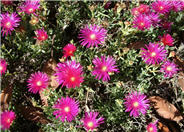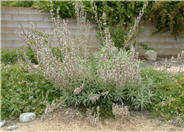
Common name:Commom Yarrow
Botanical name:Achillea millefolium
This Achillea features spreading mats of fern-like rosettes, along with deeply divided leaves of a green or gray green color. In this form, the flowers are usually a white tone. Stems can reach 2'-3' above foliage. Yarrows propagate easily from rooted cuttings or division, which should be performed in the early spring or fall. Following bloom, one should dead head the plant and divide the clumps when it appears crowded.

Common name:Trailing Ice Plant
Botanical name:Lampranthus spectabilis
This succulent groundcover is a moderately fast grower, spreading 2' wide and mounding and can grow 6"-12" tall. During the spring, it is covered with flowers could be shades of pink, purple or white. Leaves are gray green. This mounding succulent does best in full sun and is drought tolerant. It needs good drainage. It may need to be periodically cut back to rejuvenate the plant.

Common name:Blue Fescue, Blue Fescuegrass
Botanical name:Festuca glauca
This groundcover/grass will grow less than 1' tall and has small, blue green leaves.

Common name:White Sage, Sacred White Sage
Botanical name:Salvia apiana
This woody shrub has long stems with silvery white leaves and fragrant white flowers that bloom in the spring. It provides a strong structural form as a garden focal point. It can reach 6' tall and 6' wide.

Common name:Huachuca Agave, Orange Century Plan
Botanical name:Agave parryi v. huachucensis
This Agave grows slowly to 2' by 2'. It is lump forming with dense rosettes. It has short gray leaves with dark thorns on the margins. This is the largest of the subspecies of parryi with leaves 2' long. It is native to parts of AZ and is more robust, with larger leaves and broader panicles and larger flowers than the species. It is primarily found in oak and pine woodlands.-Mountain States Nursery
| Designer: Minanda L.D. + Carrillo's | DG Path |
Photographer: GardenSoft |
Soils and Compost:
Incorporate compost 6" into your soil to retain water, reduce compaction, feed earthworms, and provide valuable nutrients to your plants.
Water Saving Tip:
Apply as little fertilizer as possible.
If you use fertilizer make sure it stays on the landscape, and carefully water it in so there is NO runoff.
Integrated Pest Management:
Remove irrigation water and fertilizer from areas where you don't want weeds to grow.
